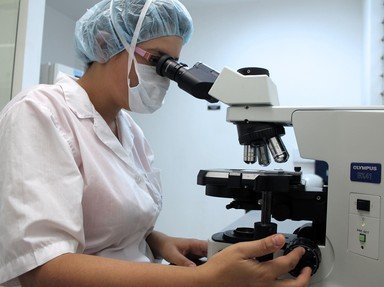Quiz Answer Key and Fun Facts
1. Many cells are easily identified by their shapes. Here, we see some human cells. Even if you don't know what exactly they are, some thinking about the purpose of the cells should tell you these are which type?
2. Here, we see a point where three cells meet. An expert might recognize the species, but just from the look of the division between the cells, you can safely state that these are from which type of life?
3. The internal structures can also sometimes tell you a lot about a cell. In this case, one of these four structures is not something you would normally see in a cell at rest. Which one of them tells the cell sleuth something and what is the verdict? (Click on the image to zoom if you need a clearer picture)
4. Here we have a rather large cell organelle that clearly shows some subdivisions. It is also something a human cell usually has exactly one of. Which is it?
5. This organelle looks almost like a fingerprint but it is rather a network to which other, very small but important cell components attach while doing their function. Its name also suggests "little network" in Latin; which organelle is it?
6. This image belongs to the same cell as the one before, but here, there are black structures embedded. They are not attached to the network but just happen to be here because the network needs a lot of energy. What is the name of these organelles?
7. This is not a detached part of the cellular component seen in question 5, but a rather different organelle whose main function is to transport vesicles - capsules containing important chemicals - to their destination. What is its rather mechanical name?
8. Here we are looking at a rather rare perspective of one particular organelle that actually has the shape of a drinking straw. The photo shows one of its ends and its microstructure involving nine small bundles of what again looks like straws. The name of this organelle is misleading, considering it rather organizes the peripheral structure of the cell. What do you see here?
9. Uh-oh! Something is happening here! What is going on in this particular picture? The process is definitely more advantageous to the particles on the left than to the mass on the right.
10. Finally, let's take a look at some chromosomes. These three chromosome pairs have been taken from a human karyotype image. Which of the following statements about them is definitely WRONG, keeping in mind the convention for labeling chromosomes?
Source: Author
WesleyCrusher
This quiz was reviewed by FunTrivia editor
crisw before going online.
Any errors found in FunTrivia content are routinely corrected through our feedback system.

